NUR272 Palliative Rehabilitation and Continuing Care
VerifiedAdded on 2023/06/08
|10
|2948
|206
AI Summary
This article discusses the diagnosis, assessment, and management of COPD, fatigue, and constipation in NUR272 Palliative Rehabilitation and Continuing Care. It also provides guidance and assistance for post-discharge management.
Contribute Materials
Your contribution can guide someone’s learning journey. Share your
documents today.
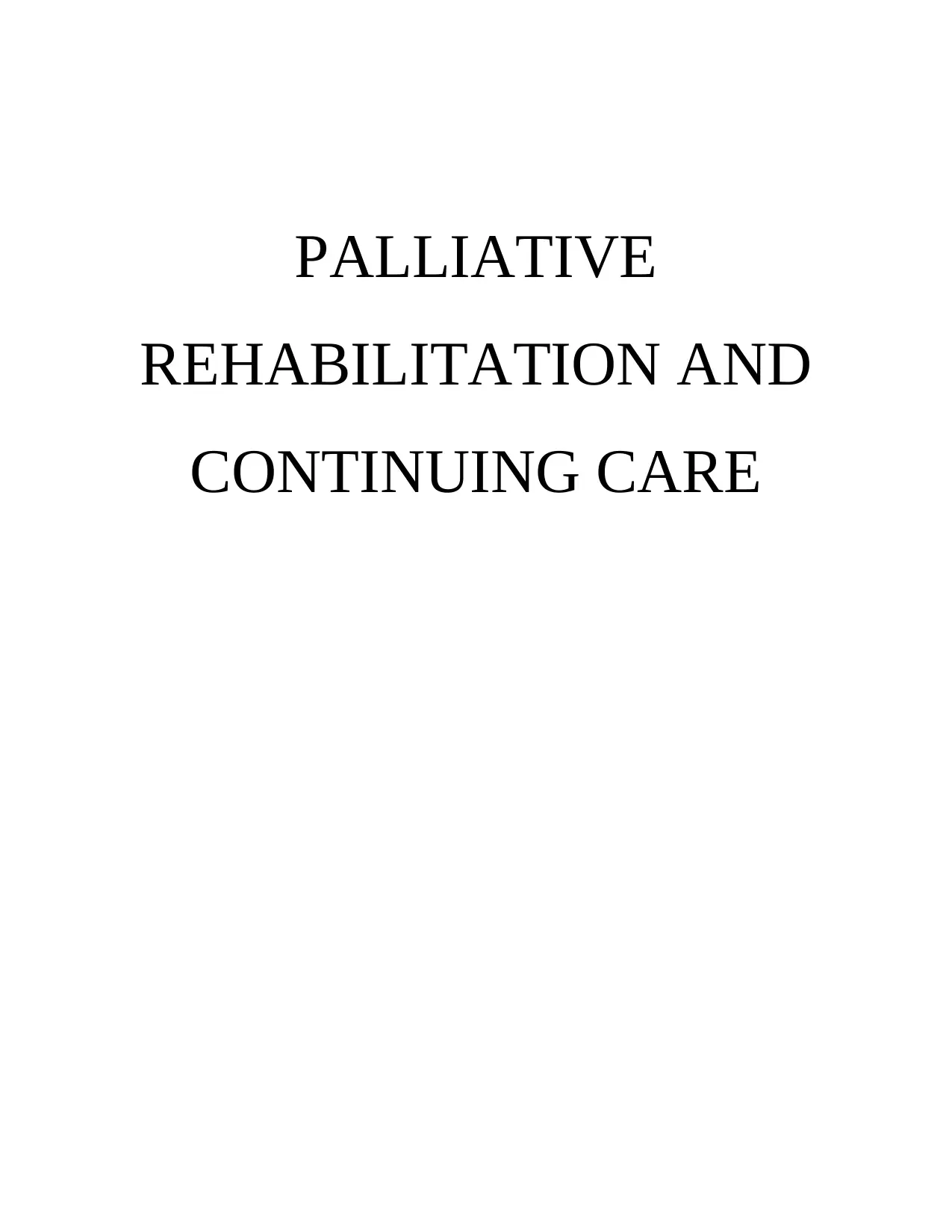
PALLIATIVE
REHABILITATION AND
CONTINUING CARE
REHABILITATION AND
CONTINUING CARE
Secure Best Marks with AI Grader
Need help grading? Try our AI Grader for instant feedback on your assignments.
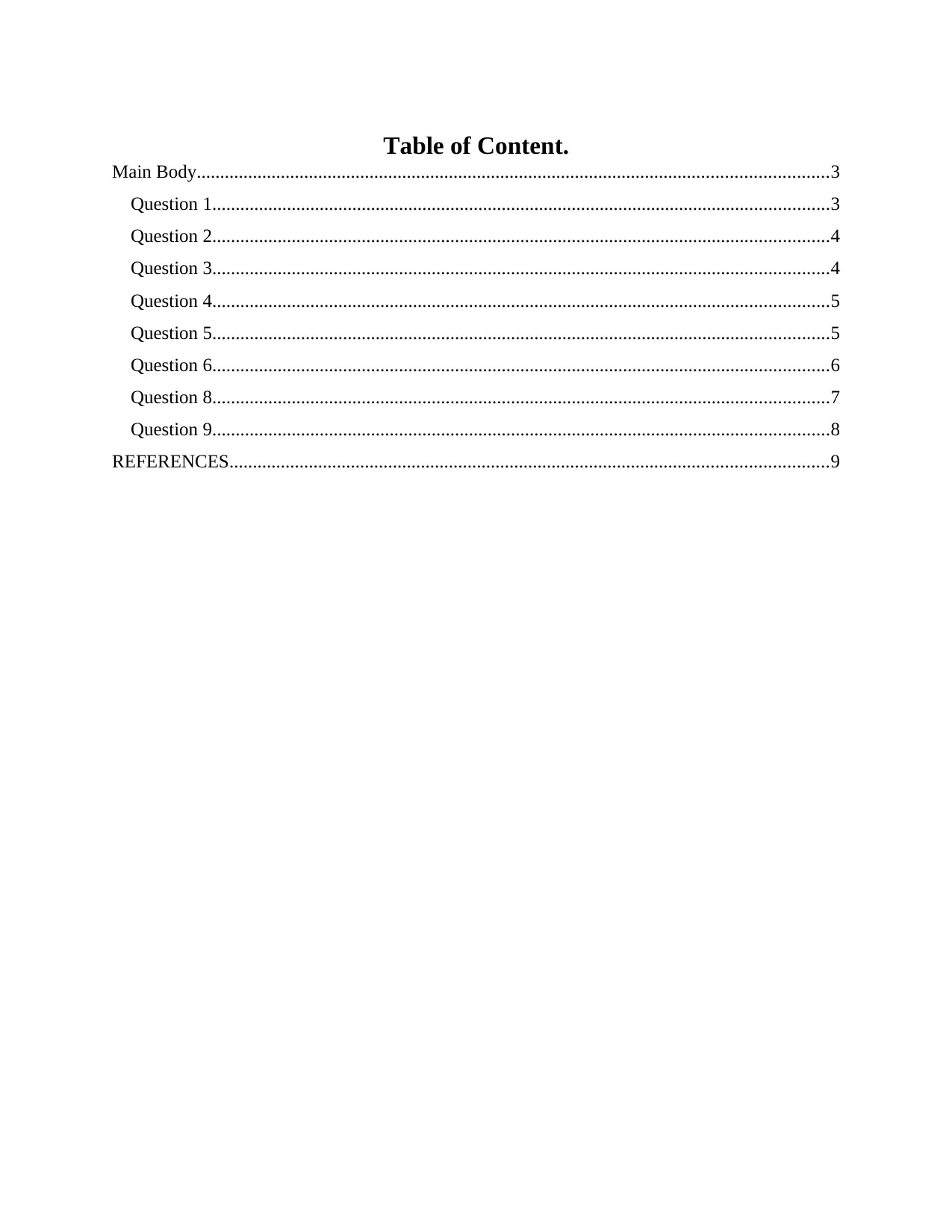
Table of Content.
Main Body.......................................................................................................................................3
Question 1....................................................................................................................................3
Question 2....................................................................................................................................4
Question 3....................................................................................................................................4
Question 4....................................................................................................................................5
Question 5....................................................................................................................................5
Question 6....................................................................................................................................6
Question 8....................................................................................................................................7
Question 9....................................................................................................................................8
REFERENCES................................................................................................................................9
Main Body.......................................................................................................................................3
Question 1....................................................................................................................................3
Question 2....................................................................................................................................4
Question 3....................................................................................................................................4
Question 4....................................................................................................................................5
Question 5....................................................................................................................................5
Question 6....................................................................................................................................6
Question 8....................................................................................................................................7
Question 9....................................................................................................................................8
REFERENCES................................................................................................................................9
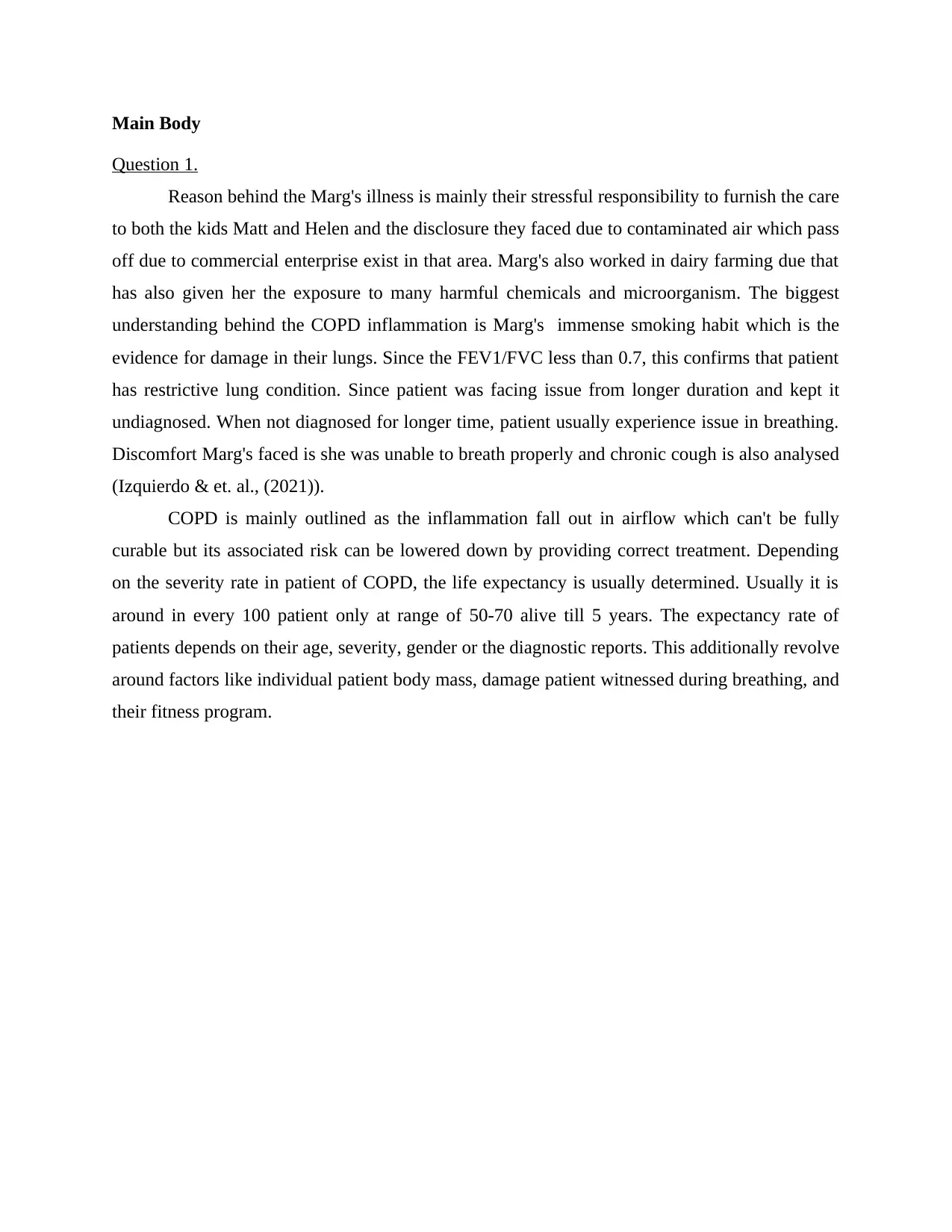
Main Body
Question 1.
Reason behind the Marg's illness is mainly their stressful responsibility to furnish the care
to both the kids Matt and Helen and the disclosure they faced due to contaminated air which pass
off due to commercial enterprise exist in that area. Marg's also worked in dairy farming due that
has also given her the exposure to many harmful chemicals and microorganism. The biggest
understanding behind the COPD inflammation is Marg's immense smoking habit which is the
evidence for damage in their lungs. Since the FEV1/FVC less than 0.7, this confirms that patient
has restrictive lung condition. Since patient was facing issue from longer duration and kept it
undiagnosed. When not diagnosed for longer time, patient usually experience issue in breathing.
Discomfort Marg's faced is she was unable to breath properly and chronic cough is also analysed
(Izquierdo & et. al., (2021)).
COPD is mainly outlined as the inflammation fall out in airflow which can't be fully
curable but its associated risk can be lowered down by providing correct treatment. Depending
on the severity rate in patient of COPD, the life expectancy is usually determined. Usually it is
around in every 100 patient only at range of 50-70 alive till 5 years. The expectancy rate of
patients depends on their age, severity, gender or the diagnostic reports. This additionally revolve
around factors like individual patient body mass, damage patient witnessed during breathing, and
their fitness program.
Question 1.
Reason behind the Marg's illness is mainly their stressful responsibility to furnish the care
to both the kids Matt and Helen and the disclosure they faced due to contaminated air which pass
off due to commercial enterprise exist in that area. Marg's also worked in dairy farming due that
has also given her the exposure to many harmful chemicals and microorganism. The biggest
understanding behind the COPD inflammation is Marg's immense smoking habit which is the
evidence for damage in their lungs. Since the FEV1/FVC less than 0.7, this confirms that patient
has restrictive lung condition. Since patient was facing issue from longer duration and kept it
undiagnosed. When not diagnosed for longer time, patient usually experience issue in breathing.
Discomfort Marg's faced is she was unable to breath properly and chronic cough is also analysed
(Izquierdo & et. al., (2021)).
COPD is mainly outlined as the inflammation fall out in airflow which can't be fully
curable but its associated risk can be lowered down by providing correct treatment. Depending
on the severity rate in patient of COPD, the life expectancy is usually determined. Usually it is
around in every 100 patient only at range of 50-70 alive till 5 years. The expectancy rate of
patients depends on their age, severity, gender or the diagnostic reports. This additionally revolve
around factors like individual patient body mass, damage patient witnessed during breathing, and
their fitness program.
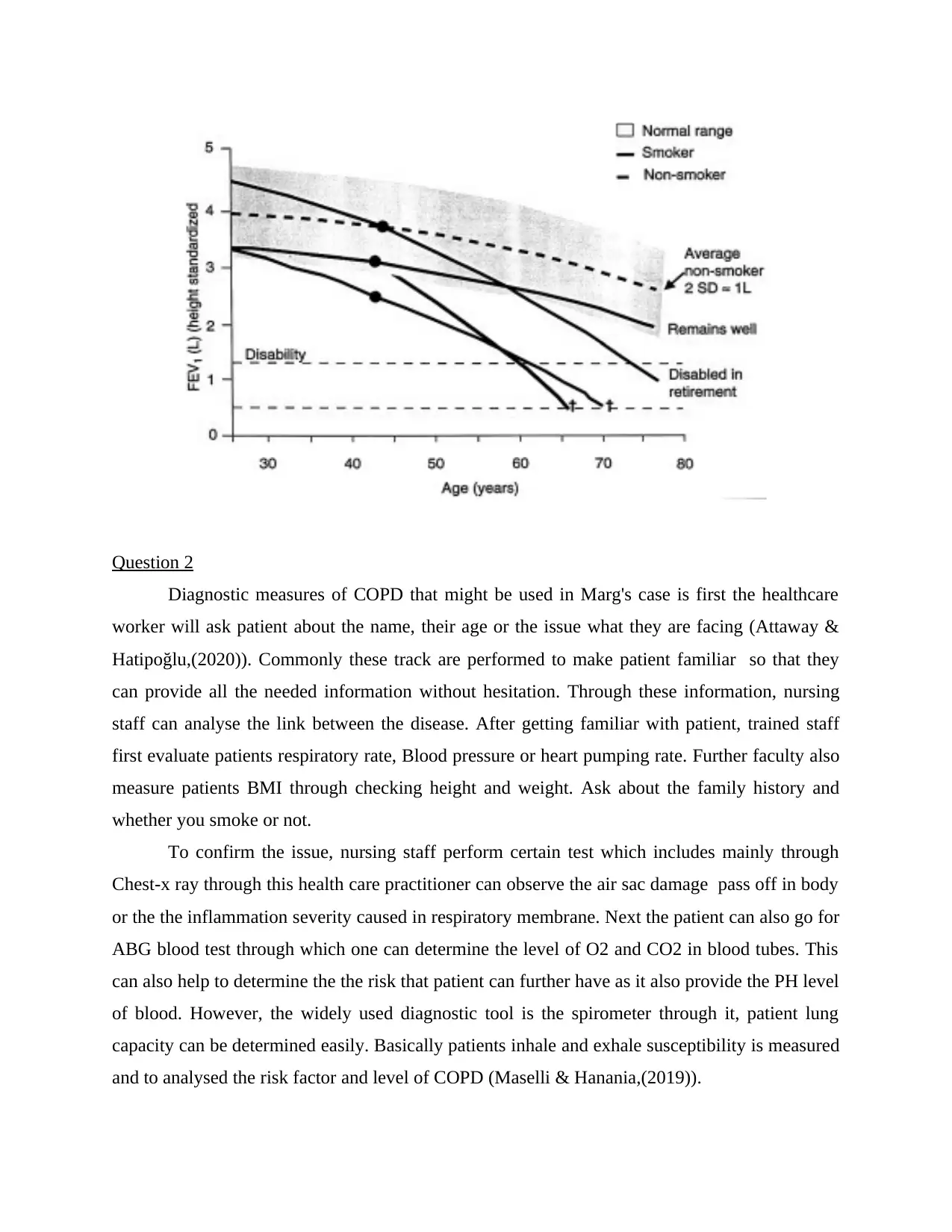
Question 2
Diagnostic measures of COPD that might be used in Marg's case is first the healthcare
worker will ask patient about the name, their age or the issue what they are facing (Attaway &
Hatipoğlu,(2020)). Commonly these track are performed to make patient familiar so that they
can provide all the needed information without hesitation. Through these information, nursing
staff can analyse the link between the disease. After getting familiar with patient, trained staff
first evaluate patients respiratory rate, Blood pressure or heart pumping rate. Further faculty also
measure patients BMI through checking height and weight. Ask about the family history and
whether you smoke or not.
To confirm the issue, nursing staff perform certain test which includes mainly through
Chest-x ray through this health care practitioner can observe the air sac damage pass off in body
or the the inflammation severity caused in respiratory membrane. Next the patient can also go for
ABG blood test through which one can determine the level of O2 and CO2 in blood tubes. This
can also help to determine the the risk that patient can further have as it also provide the PH level
of blood. However, the widely used diagnostic tool is the spirometer through it, patient lung
capacity can be determined easily. Basically patients inhale and exhale susceptibility is measured
and to analysed the risk factor and level of COPD (Maselli & Hanania,(2019)).
Diagnostic measures of COPD that might be used in Marg's case is first the healthcare
worker will ask patient about the name, their age or the issue what they are facing (Attaway &
Hatipoğlu,(2020)). Commonly these track are performed to make patient familiar so that they
can provide all the needed information without hesitation. Through these information, nursing
staff can analyse the link between the disease. After getting familiar with patient, trained staff
first evaluate patients respiratory rate, Blood pressure or heart pumping rate. Further faculty also
measure patients BMI through checking height and weight. Ask about the family history and
whether you smoke or not.
To confirm the issue, nursing staff perform certain test which includes mainly through
Chest-x ray through this health care practitioner can observe the air sac damage pass off in body
or the the inflammation severity caused in respiratory membrane. Next the patient can also go for
ABG blood test through which one can determine the level of O2 and CO2 in blood tubes. This
can also help to determine the the risk that patient can further have as it also provide the PH level
of blood. However, the widely used diagnostic tool is the spirometer through it, patient lung
capacity can be determined easily. Basically patients inhale and exhale susceptibility is measured
and to analysed the risk factor and level of COPD (Maselli & Hanania,(2019)).
Secure Best Marks with AI Grader
Need help grading? Try our AI Grader for instant feedback on your assignments.
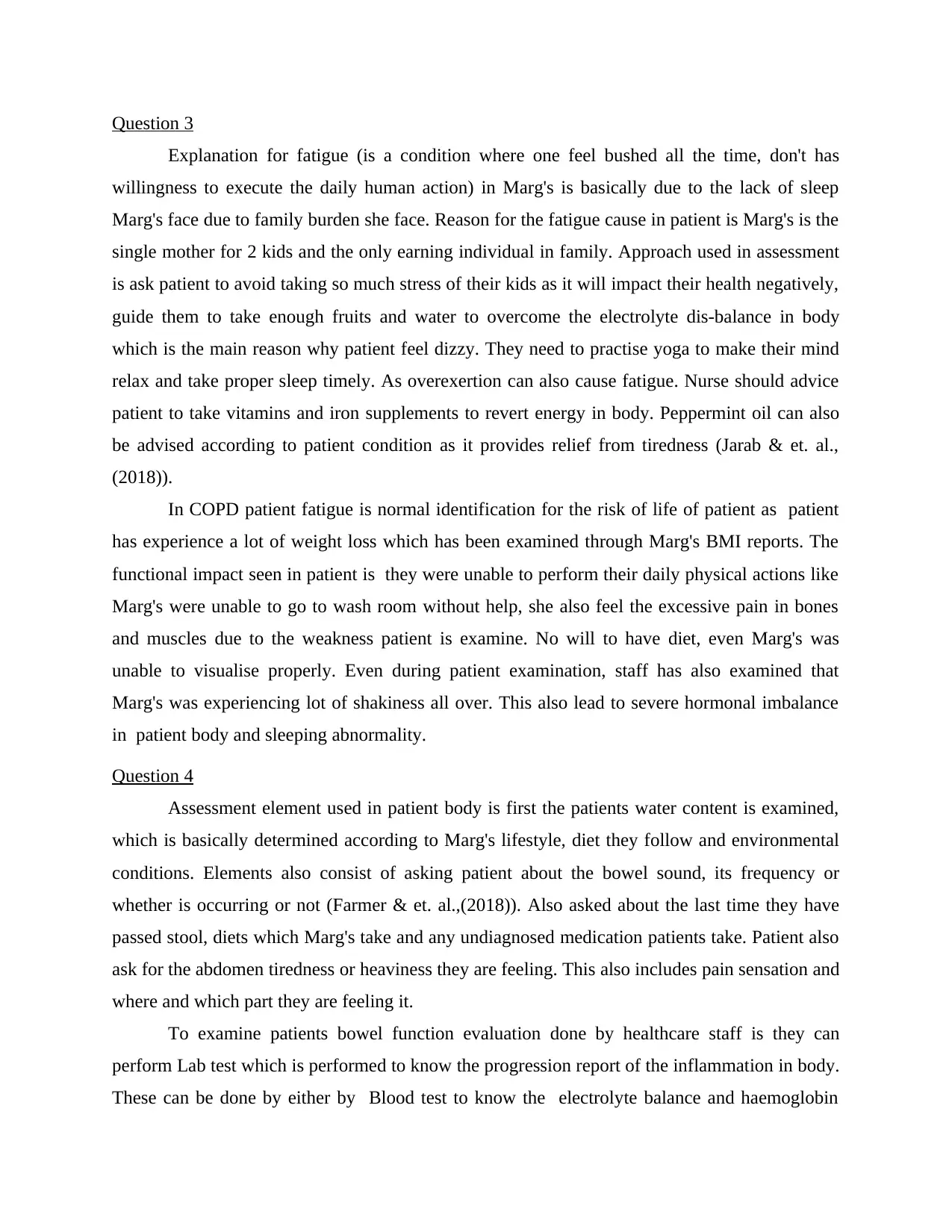
Question 3
Explanation for fatigue (is a condition where one feel bushed all the time, don't has
willingness to execute the daily human action) in Marg's is basically due to the lack of sleep
Marg's face due to family burden she face. Reason for the fatigue cause in patient is Marg's is the
single mother for 2 kids and the only earning individual in family. Approach used in assessment
is ask patient to avoid taking so much stress of their kids as it will impact their health negatively,
guide them to take enough fruits and water to overcome the electrolyte dis-balance in body
which is the main reason why patient feel dizzy. They need to practise yoga to make their mind
relax and take proper sleep timely. As overexertion can also cause fatigue. Nurse should advice
patient to take vitamins and iron supplements to revert energy in body. Peppermint oil can also
be advised according to patient condition as it provides relief from tiredness (Jarab & et. al.,
(2018)).
In COPD patient fatigue is normal identification for the risk of life of patient as patient
has experience a lot of weight loss which has been examined through Marg's BMI reports. The
functional impact seen in patient is they were unable to perform their daily physical actions like
Marg's were unable to go to wash room without help, she also feel the excessive pain in bones
and muscles due to the weakness patient is examine. No will to have diet, even Marg's was
unable to visualise properly. Even during patient examination, staff has also examined that
Marg's was experiencing lot of shakiness all over. This also lead to severe hormonal imbalance
in patient body and sleeping abnormality.
Question 4
Assessment element used in patient body is first the patients water content is examined,
which is basically determined according to Marg's lifestyle, diet they follow and environmental
conditions. Elements also consist of asking patient about the bowel sound, its frequency or
whether is occurring or not (Farmer & et. al.,(2018)). Also asked about the last time they have
passed stool, diets which Marg's take and any undiagnosed medication patients take. Patient also
ask for the abdomen tiredness or heaviness they are feeling. This also includes pain sensation and
where and which part they are feeling it.
To examine patients bowel function evaluation done by healthcare staff is they can
perform Lab test which is performed to know the progression report of the inflammation in body.
These can be done by either by Blood test to know the electrolyte balance and haemoglobin
Explanation for fatigue (is a condition where one feel bushed all the time, don't has
willingness to execute the daily human action) in Marg's is basically due to the lack of sleep
Marg's face due to family burden she face. Reason for the fatigue cause in patient is Marg's is the
single mother for 2 kids and the only earning individual in family. Approach used in assessment
is ask patient to avoid taking so much stress of their kids as it will impact their health negatively,
guide them to take enough fruits and water to overcome the electrolyte dis-balance in body
which is the main reason why patient feel dizzy. They need to practise yoga to make their mind
relax and take proper sleep timely. As overexertion can also cause fatigue. Nurse should advice
patient to take vitamins and iron supplements to revert energy in body. Peppermint oil can also
be advised according to patient condition as it provides relief from tiredness (Jarab & et. al.,
(2018)).
In COPD patient fatigue is normal identification for the risk of life of patient as patient
has experience a lot of weight loss which has been examined through Marg's BMI reports. The
functional impact seen in patient is they were unable to perform their daily physical actions like
Marg's were unable to go to wash room without help, she also feel the excessive pain in bones
and muscles due to the weakness patient is examine. No will to have diet, even Marg's was
unable to visualise properly. Even during patient examination, staff has also examined that
Marg's was experiencing lot of shakiness all over. This also lead to severe hormonal imbalance
in patient body and sleeping abnormality.
Question 4
Assessment element used in patient body is first the patients water content is examined,
which is basically determined according to Marg's lifestyle, diet they follow and environmental
conditions. Elements also consist of asking patient about the bowel sound, its frequency or
whether is occurring or not (Farmer & et. al.,(2018)). Also asked about the last time they have
passed stool, diets which Marg's take and any undiagnosed medication patients take. Patient also
ask for the abdomen tiredness or heaviness they are feeling. This also includes pain sensation and
where and which part they are feeling it.
To examine patients bowel function evaluation done by healthcare staff is they can
perform Lab test which is performed to know the progression report of the inflammation in body.
These can be done by either by Blood test to know the electrolyte balance and haemoglobin
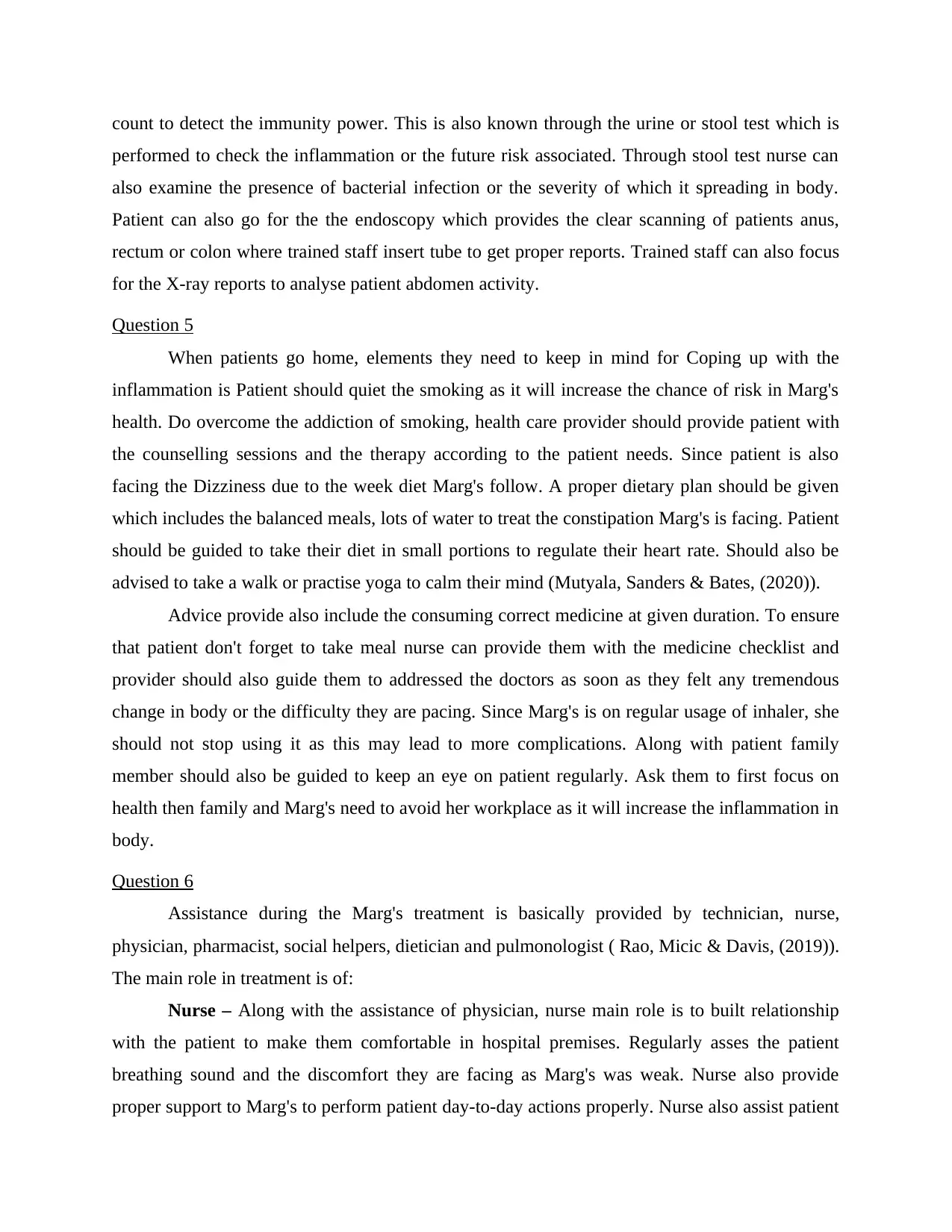
count to detect the immunity power. This is also known through the urine or stool test which is
performed to check the inflammation or the future risk associated. Through stool test nurse can
also examine the presence of bacterial infection or the severity of which it spreading in body.
Patient can also go for the the endoscopy which provides the clear scanning of patients anus,
rectum or colon where trained staff insert tube to get proper reports. Trained staff can also focus
for the X-ray reports to analyse patient abdomen activity.
Question 5
When patients go home, elements they need to keep in mind for Coping up with the
inflammation is Patient should quiet the smoking as it will increase the chance of risk in Marg's
health. Do overcome the addiction of smoking, health care provider should provide patient with
the counselling sessions and the therapy according to the patient needs. Since patient is also
facing the Dizziness due to the week diet Marg's follow. A proper dietary plan should be given
which includes the balanced meals, lots of water to treat the constipation Marg's is facing. Patient
should be guided to take their diet in small portions to regulate their heart rate. Should also be
advised to take a walk or practise yoga to calm their mind (Mutyala, Sanders & Bates, (2020)).
Advice provide also include the consuming correct medicine at given duration. To ensure
that patient don't forget to take meal nurse can provide them with the medicine checklist and
provider should also guide them to addressed the doctors as soon as they felt any tremendous
change in body or the difficulty they are pacing. Since Marg's is on regular usage of inhaler, she
should not stop using it as this may lead to more complications. Along with patient family
member should also be guided to keep an eye on patient regularly. Ask them to first focus on
health then family and Marg's need to avoid her workplace as it will increase the inflammation in
body.
Question 6
Assistance during the Marg's treatment is basically provided by technician, nurse,
physician, pharmacist, social helpers, dietician and pulmonologist ( Rao, Micic & Davis, (2019)).
The main role in treatment is of:
Nurse – Along with the assistance of physician, nurse main role is to built relationship
with the patient to make them comfortable in hospital premises. Regularly asses the patient
breathing sound and the discomfort they are facing as Marg's was weak. Nurse also provide
proper support to Marg's to perform patient day-to-day actions properly. Nurse also assist patient
performed to check the inflammation or the future risk associated. Through stool test nurse can
also examine the presence of bacterial infection or the severity of which it spreading in body.
Patient can also go for the the endoscopy which provides the clear scanning of patients anus,
rectum or colon where trained staff insert tube to get proper reports. Trained staff can also focus
for the X-ray reports to analyse patient abdomen activity.
Question 5
When patients go home, elements they need to keep in mind for Coping up with the
inflammation is Patient should quiet the smoking as it will increase the chance of risk in Marg's
health. Do overcome the addiction of smoking, health care provider should provide patient with
the counselling sessions and the therapy according to the patient needs. Since patient is also
facing the Dizziness due to the week diet Marg's follow. A proper dietary plan should be given
which includes the balanced meals, lots of water to treat the constipation Marg's is facing. Patient
should be guided to take their diet in small portions to regulate their heart rate. Should also be
advised to take a walk or practise yoga to calm their mind (Mutyala, Sanders & Bates, (2020)).
Advice provide also include the consuming correct medicine at given duration. To ensure
that patient don't forget to take meal nurse can provide them with the medicine checklist and
provider should also guide them to addressed the doctors as soon as they felt any tremendous
change in body or the difficulty they are pacing. Since Marg's is on regular usage of inhaler, she
should not stop using it as this may lead to more complications. Along with patient family
member should also be guided to keep an eye on patient regularly. Ask them to first focus on
health then family and Marg's need to avoid her workplace as it will increase the inflammation in
body.
Question 6
Assistance during the Marg's treatment is basically provided by technician, nurse,
physician, pharmacist, social helpers, dietician and pulmonologist ( Rao, Micic & Davis, (2019)).
The main role in treatment is of:
Nurse – Along with the assistance of physician, nurse main role is to built relationship
with the patient to make them comfortable in hospital premises. Regularly asses the patient
breathing sound and the discomfort they are facing as Marg's was weak. Nurse also provide
proper support to Marg's to perform patient day-to-day actions properly. Nurse also assist patient
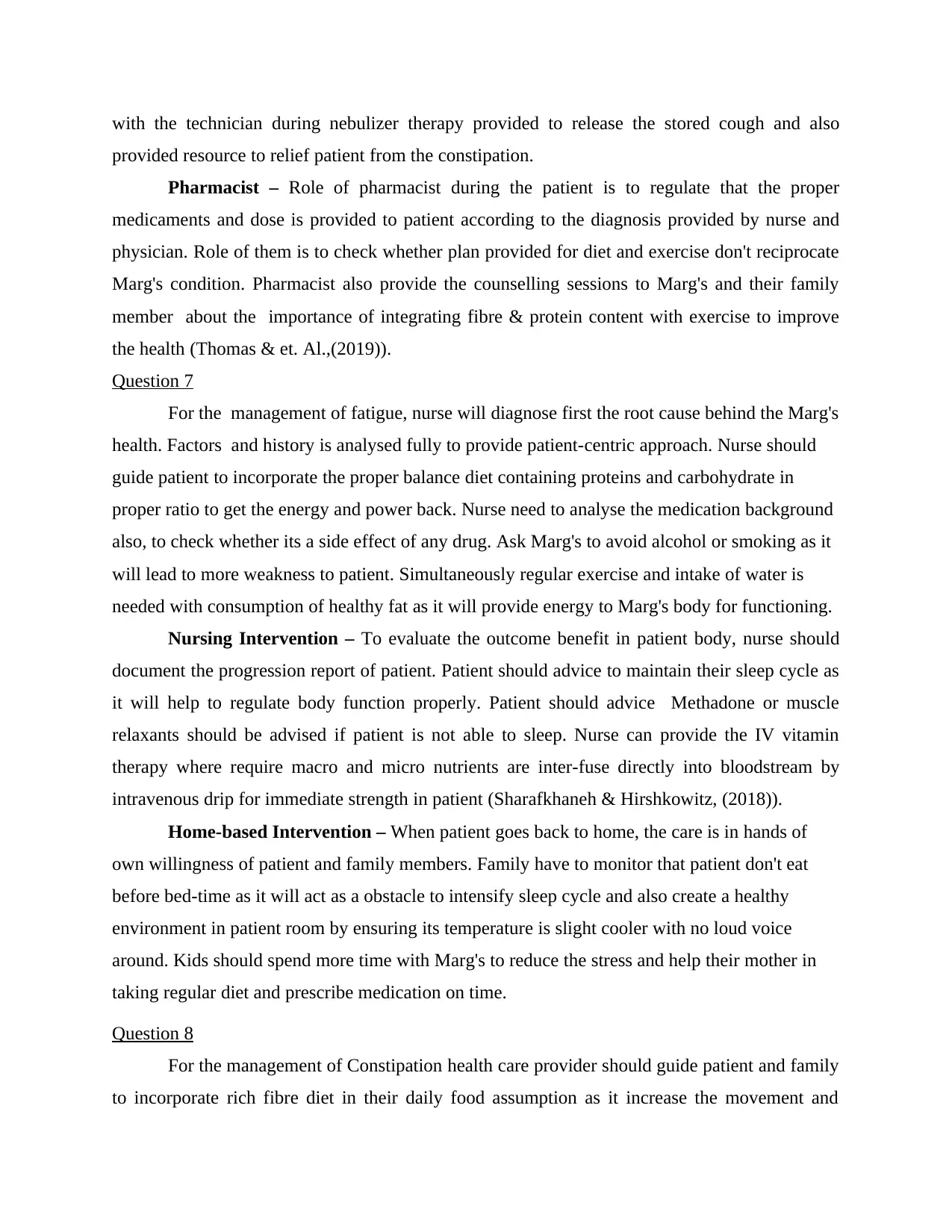
with the technician during nebulizer therapy provided to release the stored cough and also
provided resource to relief patient from the constipation.
Pharmacist – Role of pharmacist during the patient is to regulate that the proper
medicaments and dose is provided to patient according to the diagnosis provided by nurse and
physician. Role of them is to check whether plan provided for diet and exercise don't reciprocate
Marg's condition. Pharmacist also provide the counselling sessions to Marg's and their family
member about the importance of integrating fibre & protein content with exercise to improve
the health (Thomas & et. Al.,(2019)).
Question 7
For the management of fatigue, nurse will diagnose first the root cause behind the Marg's
health. Factors and history is analysed fully to provide patient-centric approach. Nurse should
guide patient to incorporate the proper balance diet containing proteins and carbohydrate in
proper ratio to get the energy and power back. Nurse need to analyse the medication background
also, to check whether its a side effect of any drug. Ask Marg's to avoid alcohol or smoking as it
will lead to more weakness to patient. Simultaneously regular exercise and intake of water is
needed with consumption of healthy fat as it will provide energy to Marg's body for functioning.
Nursing Intervention – To evaluate the outcome benefit in patient body, nurse should
document the progression report of patient. Patient should advice to maintain their sleep cycle as
it will help to regulate body function properly. Patient should advice Methadone or muscle
relaxants should be advised if patient is not able to sleep. Nurse can provide the IV vitamin
therapy where require macro and micro nutrients are inter-fuse directly into bloodstream by
intravenous drip for immediate strength in patient (Sharafkhaneh & Hirshkowitz, (2018)).
Home-based Intervention – When patient goes back to home, the care is in hands of
own willingness of patient and family members. Family have to monitor that patient don't eat
before bed-time as it will act as a obstacle to intensify sleep cycle and also create a healthy
environment in patient room by ensuring its temperature is slight cooler with no loud voice
around. Kids should spend more time with Marg's to reduce the stress and help their mother in
taking regular diet and prescribe medication on time.
Question 8
For the management of Constipation health care provider should guide patient and family
to incorporate rich fibre diet in their daily food assumption as it increase the movement and
provided resource to relief patient from the constipation.
Pharmacist – Role of pharmacist during the patient is to regulate that the proper
medicaments and dose is provided to patient according to the diagnosis provided by nurse and
physician. Role of them is to check whether plan provided for diet and exercise don't reciprocate
Marg's condition. Pharmacist also provide the counselling sessions to Marg's and their family
member about the importance of integrating fibre & protein content with exercise to improve
the health (Thomas & et. Al.,(2019)).
Question 7
For the management of fatigue, nurse will diagnose first the root cause behind the Marg's
health. Factors and history is analysed fully to provide patient-centric approach. Nurse should
guide patient to incorporate the proper balance diet containing proteins and carbohydrate in
proper ratio to get the energy and power back. Nurse need to analyse the medication background
also, to check whether its a side effect of any drug. Ask Marg's to avoid alcohol or smoking as it
will lead to more weakness to patient. Simultaneously regular exercise and intake of water is
needed with consumption of healthy fat as it will provide energy to Marg's body for functioning.
Nursing Intervention – To evaluate the outcome benefit in patient body, nurse should
document the progression report of patient. Patient should advice to maintain their sleep cycle as
it will help to regulate body function properly. Patient should advice Methadone or muscle
relaxants should be advised if patient is not able to sleep. Nurse can provide the IV vitamin
therapy where require macro and micro nutrients are inter-fuse directly into bloodstream by
intravenous drip for immediate strength in patient (Sharafkhaneh & Hirshkowitz, (2018)).
Home-based Intervention – When patient goes back to home, the care is in hands of
own willingness of patient and family members. Family have to monitor that patient don't eat
before bed-time as it will act as a obstacle to intensify sleep cycle and also create a healthy
environment in patient room by ensuring its temperature is slight cooler with no loud voice
around. Kids should spend more time with Marg's to reduce the stress and help their mother in
taking regular diet and prescribe medication on time.
Question 8
For the management of Constipation health care provider should guide patient and family
to incorporate rich fibre diet in their daily food assumption as it increase the movement and
Paraphrase This Document
Need a fresh take? Get an instant paraphrase of this document with our AI Paraphraser
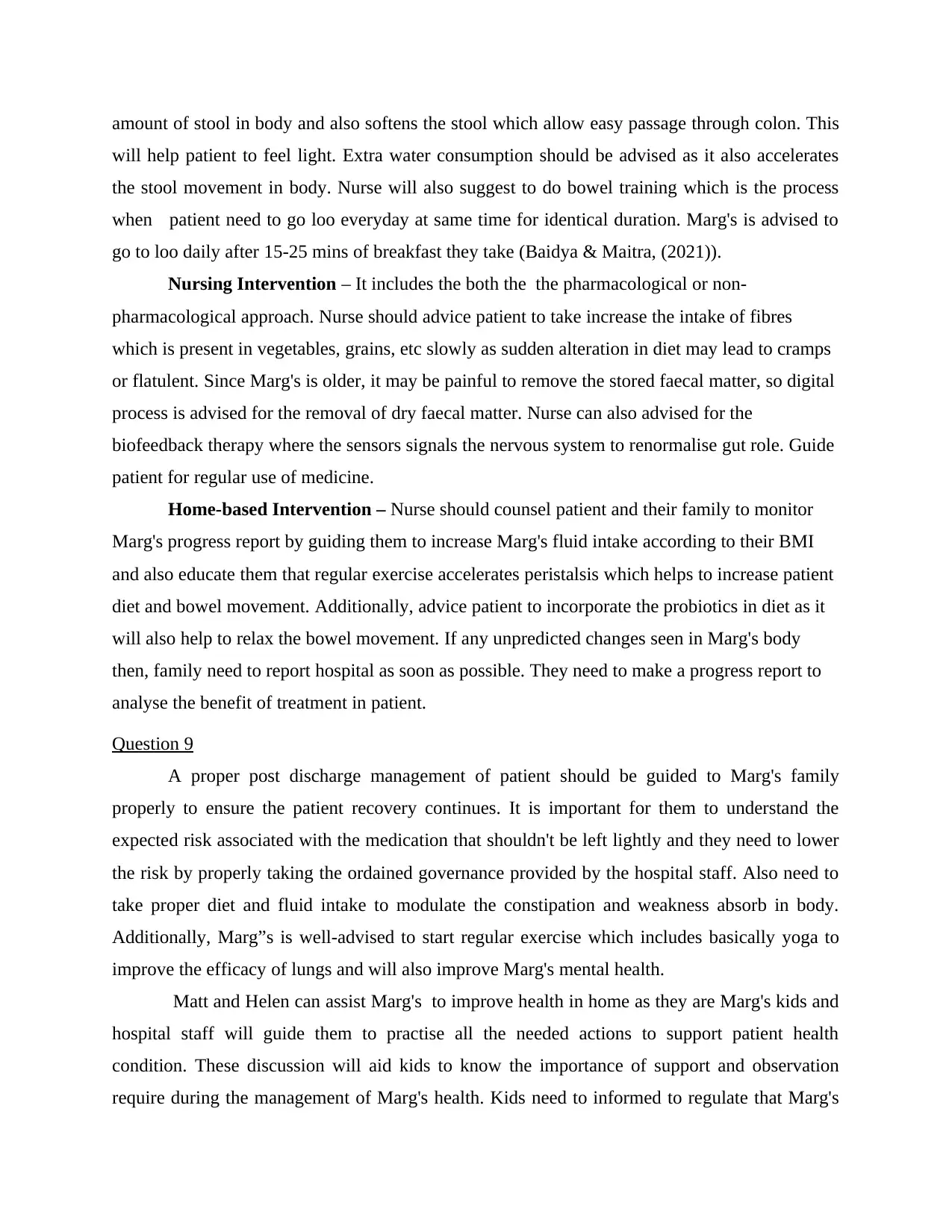
amount of stool in body and also softens the stool which allow easy passage through colon. This
will help patient to feel light. Extra water consumption should be advised as it also accelerates
the stool movement in body. Nurse will also suggest to do bowel training which is the process
when patient need to go loo everyday at same time for identical duration. Marg's is advised to
go to loo daily after 15-25 mins of breakfast they take (Baidya & Maitra, (2021)).
Nursing Intervention – It includes the both the the pharmacological or non-
pharmacological approach. Nurse should advice patient to take increase the intake of fibres
which is present in vegetables, grains, etc slowly as sudden alteration in diet may lead to cramps
or flatulent. Since Marg's is older, it may be painful to remove the stored faecal matter, so digital
process is advised for the removal of dry faecal matter. Nurse can also advised for the
biofeedback therapy where the sensors signals the nervous system to renormalise gut role. Guide
patient for regular use of medicine.
Home-based Intervention – Nurse should counsel patient and their family to monitor
Marg's progress report by guiding them to increase Marg's fluid intake according to their BMI
and also educate them that regular exercise accelerates peristalsis which helps to increase patient
diet and bowel movement. Additionally, advice patient to incorporate the probiotics in diet as it
will also help to relax the bowel movement. If any unpredicted changes seen in Marg's body
then, family need to report hospital as soon as possible. They need to make a progress report to
analyse the benefit of treatment in patient.
Question 9
A proper post discharge management of patient should be guided to Marg's family
properly to ensure the patient recovery continues. It is important for them to understand the
expected risk associated with the medication that shouldn't be left lightly and they need to lower
the risk by properly taking the ordained governance provided by the hospital staff. Also need to
take proper diet and fluid intake to modulate the constipation and weakness absorb in body.
Additionally, Marg”s is well-advised to start regular exercise which includes basically yoga to
improve the efficacy of lungs and will also improve Marg's mental health.
Matt and Helen can assist Marg's to improve health in home as they are Marg's kids and
hospital staff will guide them to practise all the needed actions to support patient health
condition. These discussion will aid kids to know the importance of support and observation
require during the management of Marg's health. Kids need to informed to regulate that Marg's
will help patient to feel light. Extra water consumption should be advised as it also accelerates
the stool movement in body. Nurse will also suggest to do bowel training which is the process
when patient need to go loo everyday at same time for identical duration. Marg's is advised to
go to loo daily after 15-25 mins of breakfast they take (Baidya & Maitra, (2021)).
Nursing Intervention – It includes the both the the pharmacological or non-
pharmacological approach. Nurse should advice patient to take increase the intake of fibres
which is present in vegetables, grains, etc slowly as sudden alteration in diet may lead to cramps
or flatulent. Since Marg's is older, it may be painful to remove the stored faecal matter, so digital
process is advised for the removal of dry faecal matter. Nurse can also advised for the
biofeedback therapy where the sensors signals the nervous system to renormalise gut role. Guide
patient for regular use of medicine.
Home-based Intervention – Nurse should counsel patient and their family to monitor
Marg's progress report by guiding them to increase Marg's fluid intake according to their BMI
and also educate them that regular exercise accelerates peristalsis which helps to increase patient
diet and bowel movement. Additionally, advice patient to incorporate the probiotics in diet as it
will also help to relax the bowel movement. If any unpredicted changes seen in Marg's body
then, family need to report hospital as soon as possible. They need to make a progress report to
analyse the benefit of treatment in patient.
Question 9
A proper post discharge management of patient should be guided to Marg's family
properly to ensure the patient recovery continues. It is important for them to understand the
expected risk associated with the medication that shouldn't be left lightly and they need to lower
the risk by properly taking the ordained governance provided by the hospital staff. Also need to
take proper diet and fluid intake to modulate the constipation and weakness absorb in body.
Additionally, Marg”s is well-advised to start regular exercise which includes basically yoga to
improve the efficacy of lungs and will also improve Marg's mental health.
Matt and Helen can assist Marg's to improve health in home as they are Marg's kids and
hospital staff will guide them to practise all the needed actions to support patient health
condition. These discussion will aid kids to know the importance of support and observation
require during the management of Marg's health. Kids need to informed to regulate that Marg's

take right medicaments at accurate instance and need to avoid her workplace as it can increase
the inflammation in lungs.
the inflammation in lungs.
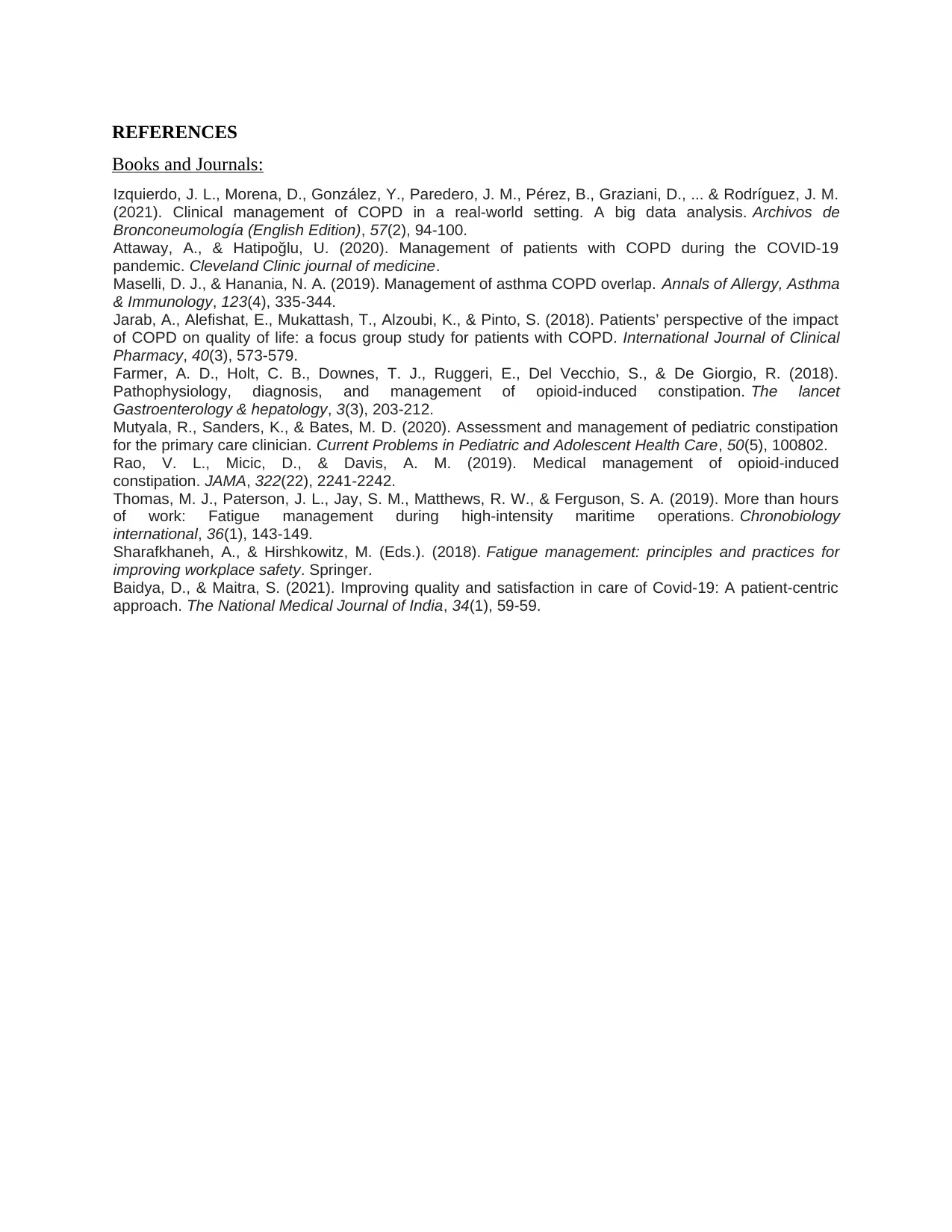
REFERENCES
Books and Journals:
Izquierdo, J. L., Morena, D., González, Y., Paredero, J. M., Pérez, B., Graziani, D., ... & Rodríguez, J. M.
(2021). Clinical management of COPD in a real-world setting. A big data analysis. Archivos de
Bronconeumología (English Edition), 57(2), 94-100.
Attaway, A., & Hatipoğlu, U. (2020). Management of patients with COPD during the COVID-19
pandemic. Cleveland Clinic journal of medicine.
Maselli, D. J., & Hanania, N. A. (2019). Management of asthma COPD overlap. Annals of Allergy, Asthma
& Immunology, 123(4), 335-344.
Jarab, A., Alefishat, E., Mukattash, T., Alzoubi, K., & Pinto, S. (2018). Patients’ perspective of the impact
of COPD on quality of life: a focus group study for patients with COPD. International Journal of Clinical
Pharmacy, 40(3), 573-579.
Farmer, A. D., Holt, C. B., Downes, T. J., Ruggeri, E., Del Vecchio, S., & De Giorgio, R. (2018).
Pathophysiology, diagnosis, and management of opioid-induced constipation. The lancet
Gastroenterology & hepatology, 3(3), 203-212.
Mutyala, R., Sanders, K., & Bates, M. D. (2020). Assessment and management of pediatric constipation
for the primary care clinician. Current Problems in Pediatric and Adolescent Health Care, 50(5), 100802.
Rao, V. L., Micic, D., & Davis, A. M. (2019). Medical management of opioid-induced
constipation. JAMA, 322(22), 2241-2242.
Thomas, M. J., Paterson, J. L., Jay, S. M., Matthews, R. W., & Ferguson, S. A. (2019). More than hours
of work: Fatigue management during high-intensity maritime operations. Chronobiology
international, 36(1), 143-149.
Sharafkhaneh, A., & Hirshkowitz, M. (Eds.). (2018). Fatigue management: principles and practices for
improving workplace safety. Springer.
Baidya, D., & Maitra, S. (2021). Improving quality and satisfaction in care of Covid-19: A patient-centric
approach. The National Medical Journal of India, 34(1), 59-59.
Books and Journals:
Izquierdo, J. L., Morena, D., González, Y., Paredero, J. M., Pérez, B., Graziani, D., ... & Rodríguez, J. M.
(2021). Clinical management of COPD in a real-world setting. A big data analysis. Archivos de
Bronconeumología (English Edition), 57(2), 94-100.
Attaway, A., & Hatipoğlu, U. (2020). Management of patients with COPD during the COVID-19
pandemic. Cleveland Clinic journal of medicine.
Maselli, D. J., & Hanania, N. A. (2019). Management of asthma COPD overlap. Annals of Allergy, Asthma
& Immunology, 123(4), 335-344.
Jarab, A., Alefishat, E., Mukattash, T., Alzoubi, K., & Pinto, S. (2018). Patients’ perspective of the impact
of COPD on quality of life: a focus group study for patients with COPD. International Journal of Clinical
Pharmacy, 40(3), 573-579.
Farmer, A. D., Holt, C. B., Downes, T. J., Ruggeri, E., Del Vecchio, S., & De Giorgio, R. (2018).
Pathophysiology, diagnosis, and management of opioid-induced constipation. The lancet
Gastroenterology & hepatology, 3(3), 203-212.
Mutyala, R., Sanders, K., & Bates, M. D. (2020). Assessment and management of pediatric constipation
for the primary care clinician. Current Problems in Pediatric and Adolescent Health Care, 50(5), 100802.
Rao, V. L., Micic, D., & Davis, A. M. (2019). Medical management of opioid-induced
constipation. JAMA, 322(22), 2241-2242.
Thomas, M. J., Paterson, J. L., Jay, S. M., Matthews, R. W., & Ferguson, S. A. (2019). More than hours
of work: Fatigue management during high-intensity maritime operations. Chronobiology
international, 36(1), 143-149.
Sharafkhaneh, A., & Hirshkowitz, M. (Eds.). (2018). Fatigue management: principles and practices for
improving workplace safety. Springer.
Baidya, D., & Maitra, S. (2021). Improving quality and satisfaction in care of Covid-19: A patient-centric
approach. The National Medical Journal of India, 34(1), 59-59.
1 out of 10
Related Documents
Your All-in-One AI-Powered Toolkit for Academic Success.
+13062052269
info@desklib.com
Available 24*7 on WhatsApp / Email
![[object Object]](/_next/static/media/star-bottom.7253800d.svg)
Unlock your academic potential
© 2024 | Zucol Services PVT LTD | All rights reserved.





